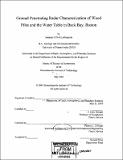| dc.contributor.advisor | F. Dale Morgan and Patricia J. Culligan. | en_US |
| dc.contributor.author | LeFrançois, Suzanne O'Neil, 1980- | en_US |
| dc.contributor.other | Massachusetts Institute of Technology. Dept. of Earth, Atmospheric, and Planetary Sciences. | en_US |
| dc.coverage.spatial | n-us-ma | en_US |
| dc.date.accessioned | 2010-10-29T18:03:01Z | |
| dc.date.available | 2010-10-29T18:03:01Z | |
| dc.date.copyright | 2003 | en_US |
| dc.date.issued | 2003 | en_US |
| dc.identifier.uri | http://hdl.handle.net/1721.1/59653 | |
| dc.description | Thesis (S.M. in Geosystems)--Massachusetts Institute of Technology, Dept. of Earth, Atmospheric, and Planetary Sciences, 2003. | en_US |
| dc.description | Includes bibliographical references (p. 103-105). | en_US |
| dc.description.abstract | Ground penetrating radar (GPR) surveys are performed to determine the depth to the water table and the tops of wood piles beneath a residential structure at 122 Beacon Street in Back Bay, Boston. The area of Boston known as the Back Bay was once a tidal estuary of the Charles River. During the latter half of the 19th century, the Back Bay was filled to create room for the city's expanding population. Most of the structures built in the Back Bay during this period were residential buildings supported by untreated wood pile foundations. Submerged beneath the water table, untreated wood piles maintain their structural integrity indefinitely. However, recent groundwater fluctuations throughout the Back Bay have exposed the tops of some of the piles, causing the exposed areas to rot. Rotted wood piles weaken a structure's foundation and often result in differential settlement or cracking in walls or foundations. The current method of investigating suspected pile failure is to excavate a foundation and to physically inspect the piles, noting the elevation of the water table. In many cases, foundations may be stabilized by underpinning: replacing rotted wood piles with steel beams or concrete plugs often at great cost to the owner of the building. The research presented in this thesis investigates the usefulness of GPR in determining the proximity of the tops of wood piles relative to the water table. Two different types of radar surveys were used in an attempt to estimate the depth to the water table and the tops of the piles. Data collected from several radar surveys is interpreted and compared with ground truth derived from historical references, water level data from monitoring wells, observations from recent excavations, and the results of a resistivity survey. The results of this study indicate that modifications of this technique may allow more definite interpretation of wood pile foundations than traditional GPR surveys can provide in this type of environment. | en_US |
| dc.description.statementofresponsibility | by Suzanne O'Neil LeFrançois. | en_US |
| dc.format.extent | 122 p. | en_US |
| dc.language.iso | eng | en_US |
| dc.publisher | Massachusetts Institute of Technology | en_US |
| dc.rights | M.I.T. theses are protected by
copyright. They may be viewed from this source for any purpose, but
reproduction or distribution in any format is prohibited without written
permission. See provided URL for inquiries about permission. | en_US |
| dc.rights.uri | http://dspace.mit.edu/handle/1721.1/7582 | en_US |
| dc.subject | Earth, Atmospheric, and Planetary Sciences. | en_US |
| dc.title | Ground penetrating radar characterization of wood piles and the water table in Back Bay, Boston | en_US |
| dc.title.alternative | GPR characterization of wood piles and the water table in Back Bay, Boston | en_US |
| dc.type | Thesis | en_US |
| dc.description.degree | S.M.in Geosystems | en_US |
| dc.contributor.department | Massachusetts Institute of Technology. Department of Earth, Atmospheric, and Planetary Sciences | |
| dc.identifier.oclc | 54535055 | en_US |
